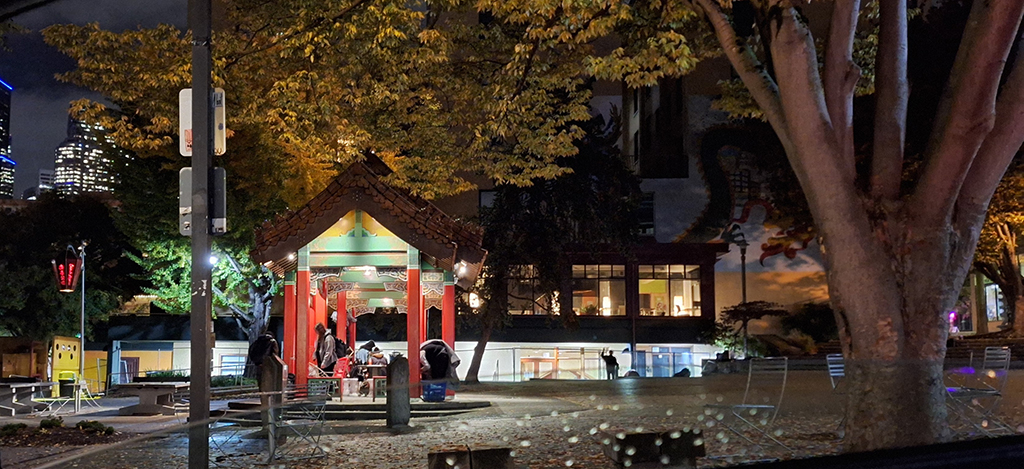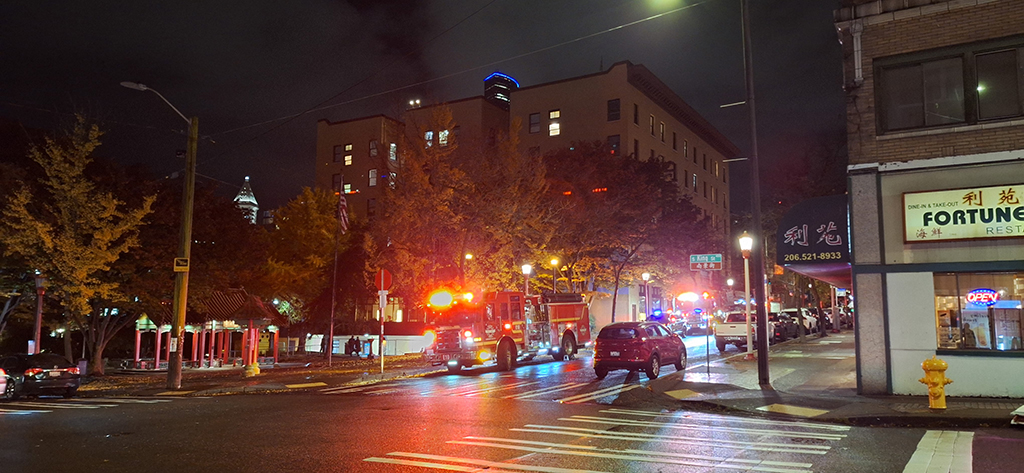By Mahlon Meyer
NORTHWEST ASIAN WEEKLY
Two weeks after Mayor Bruce Harrell met with a coalition of developers, businesses, and activists from the Chinatown-International District (CID), drug dealing, break-ins, thefts, and sprawling drug use on the streets continues.
Still, some community members have witnessed some positive change.
According to interviews with a handful of activists and business owners in Little Saigon, it appears that, if police are already in the area when a crime is reported, the response time is quick. Yet other business owners report police still failing to show up for 911 calls.
At the same time, in the two weeks since Harrell’s meeting, others have reported an abatement in overall criminal activity.
But there is still no consensus about whether this is due to more police patrols and activity, or whether it is simply due to the engulfment by fire of a tent encampment where drug dealers and users lived, according to community members.
Crime-fighting measures old and new
Many of the programs to address crime in the area were initiated over a year ago, and initially resulted in a number of arrests.
More recent programs just started, however, at the end of October and may take time to show results, Harrell’s office said.
While local activists have been astonished at the speed with which police have responded to several recent incidents, their relief is tempered by the concern of others in the community who say criminal activity has merely shifted to other parts of the neighborhood in response.
The city’s stated support for Little Saigon
Harrell issued a statement to the Asian Weekly in response to a perceived abatement in criminal activity on 12th Avenue South.
“Little Saigon is a cherished neighborhood and critical to the future of our city. Since Day One of our administration, we have worked to implement immediate and sustainable actions that make Little Saigon and the Chinatown-International District more safe, clean, and welcoming for residents, workers, small businesses, and visitors,” said the mayor. “We are grateful for the progress made, acknowledge there is more work to do, and remain steadfast in our commitment to working with the community to make the CID and Little Saigon a place where families, small businesses, workers, residents, and visitors can live, work, and play.”
Recent shooting illustrates ongoing safety problems
But the recent experiences of some community members drive home the ongoing difficulties encountered by the entire community.
One business owner, who asked not to be identified for professional reasons, on the night of Nov. 7 saw four people doing drugs outside her office with one person lying “comatose.” She saw no police patrols.
The next day, Nov. 8, she was heading to her office just one hour before a shooting occurred.
“I was on 12th and Weller around 4 p.m.,” she said. “There were six to eight people that appeared to be doing drugs on the utility box there and a couple in the driveway of the Navigation Center—they appeared strung out.”
An hour later, after leaving her office, she received a text that a shooting had occurred behind her building.
“This was the second shooting in a month that happened in close proximity to our office when people were still in the building working,” she said.
Still, she said the overall picture seems to have improved somewhat. “Since the two shootings near 12th and Weller on Oct. 3, the number of open drug deals, addicts, and illegal markets on Navigation Center property and adjoining strips has gone down,” she said.
Invasions
Another business owner, who also asked for anonymity for fear of calling attention to her establishment, described several brazen break-ins just last week.
After the first forced entry, she and her colleagues put up a new fence and installed a burglar alarm.
But a few days later, the burglars entered again, and when the alarm system activated, the intruders ripped the sound-making element out of the wall. They proceeded to steal a lawn mower, rice cookers, a weed whacker, anything they could get their hands on, the business owner said.
“We called 911, the police never showed up,” she said.
The first business owner said it appeared that at least one building in the neighborhood, 1224 South. Lane, had been neglected by its owners—and drug dealers had taken steps to secure, or take control of the property themselves, —installing gates and locks.
Quick responses
Still, community activist Susan Lee Woo has witnessed several times when police have been on scene rapidly to avert criminal activities and apprehend a suspect.
A burglary of a local dim sum restaurant was in progress last week when a community member, witnessing it, called 911. According to Woo, the police arrived in time to arrest the suspect.
In another instance she caught on film, a community member walked past what appeared to be drug dealing outside Uncle Bob’s Place and immediately flagged down a police cruiser in the area.
Police talked with the suspects and moved them along. “The team efforts of citizens and police play key roles in apprehensions of suspects and are deterrents of crime,” Woo told the Asian Weekly.
Police presence or burned down encampment?
The police have increased their visibility and presence in the CID, according to the mayor’s office, which has also resulted in the decrease of stolen goods markets.
However, the rapid change for the better just in the past few weeks may also be attributable to a fire that burned down an illegal encampment.
“The fire that burned down the illegal homeless encampment at 10th and Dearborn, just off of King, last week was primarily occupied by drug dealers and users,” said the first business owner. “It is possible that sales and use of drugs were down in Little Saigon last week due to the demise of this camp.”
Now, tents are going back up. And community members are not sure if increased crime will come back.
Trouble going after dealers?
Exacerbating the problem, dealers seem to have ways of evading police.
“The number of people loitering in Little Saigon grows in size when dealers arrive,” said the first business owner. “If the police show up, it is in response to calls from the community, and by then, the area is saturated with addicts who are openly doing drugs, occupying public areas or private property in a comatose state, or behaving erratically.”
And, by then, the dealers are gone.
In other places, dealers have simply moved from 12th Avenue South and Jackson to other parts of the neighborhood.
Community witnesses, for instance, have seen an increase in activity in Hing Hay Park recently.

As 12th Avenue South has been targeted by law enforcement, criminal activity has moved to areas like Hing Hay Park. (Photo by Susan Lee Woo)
“Any enforcement effort that disrupts the selling and distribution of drugs and other illegal activity can have a displacement effect. The Seattle Police Department regularly monitors and responds to areas where illegal activity is occurring, and will pivot enforcement efforts and tactics as necessary,” said Karissa Braxton, senior communications advisor for the mayor.

As police and undercover operations have increased in Little Saigon, criminal activity has moved elsewhere. Here, first responders were at Hing Hay Park last week. (Photo by Susan Lee Woo)
Other measures
Some initiatives by the mayor’s office commenced early last year, and it was not immediately clear to what extent they were still being enforced.
In March of 2022, Harrell coordinated an undercover operation with federal law enforcement that resulted in 16 felony arrests between January and March of that year.
Officials said it targeted dealers and helped improve the safety of 12th and Jackson.
But later in the year and up until recently, drug-dealing and criminal activity soared in the area.
More recently, the new law prohibiting public drug use, guided by an executive order, led to 25 arrests on the day it went into effect, on Oct. 20.
Half of those were addicts referred for treatment. The other half had outstanding felony warrants.
Meanwhile, the police have seized over 1,150 guns so far this year.
This “is on pace for the most guns seized in a calendar year,” said Braxton.
Another measure, launched at the end of October, is a team of behavioral health specialists who will accompany police on some calls. The program is apparently still in its inception phase.
Other measures include ongoing cleaning of the neighborhood, monthly meetings with the police crime prevention team and local businesses, plans for new murals, and the demolition of vacant buildings on the west side of the Asia Plaza site.
A new development will be six to seven stories and have 397 apartments and 6,900 square feet of ground floor commercial space. The development will include parking for 236 cars.
A close to the street perspective
During an interview with a man who gave his name as “Big Al,” several months ago, at the bus stop on 12th and Jackson, he said the area was being changed by development.
While his views represented a slice of life that was impossible to verify, they may be an indication on some level of how changes in the neighborhood are perceived by those of a different socio-economic background.
“It used to be that organized crime took a cut of all the drug dealing that went on down here,” he said. “Now all the money is in development, real estate. And they’re taking a cut of that, too.”
Mahlon can be reached at info@nwasianweekly.com.

